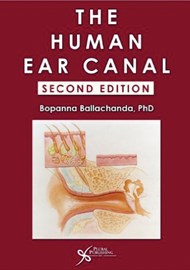If ever a book aptly lived up to its name, it would be ‘The Human Ear Canal’ by Dr Ballachandra. Not once straying from its path, this second edition aims to take the reader on a somewhat tangential tour of everything ear canal related, covering topics ranging from ear canal development, up to techniques in volumetric measurement, and modern day advances in deep canal hearing aid technology. To say that this is a hard task would be an understatement; however, Dr Ballachandra and his contributing colleagues have done a good job in writing an interesting and cohesive book.
The aim of this book is to “cover a wide range of topics pertinent to the human ear canal and its contribution to audiological services”, and this second edition improves on the original by providing more up-to-date research, and value-based perspectives, especially on the central theme of ‘Cerumen Management’.
The book itself is broken into nine distinct chapters, each covering a topic relating to the ear canal, and each make for an easily accessible read, independent of audiological experience. The initial chapters provide an overview of ear canal development, anatomy and pathology, with the latter chapters becoming more niche, reflecting the interest of the author, and the author’s research. Each chapter is well cited, bringing together old research with more modern insights published after the first edition of The Human Ear Canal was released.
The justifications for the central theme of cerumen management are made clear, and are well backed with research throughout the book, however, a considerable proportion of what is arguably the main chapter seems disappointingly devoted to the different instruments used, something also unfortunately seen in the chapter on ear canal examination, and a quick skim of the essential pages would suffice.
One of the major downfalls of this second edition is its intended target reader. The breadth of information covered within these 225 pages would catch the eye of both trainees and academics alike, as interesting topics, and an overall running theme on advances in cerumen management may be beneficial for even experienced clinicians; however, for some chapters, the depth of information provided may warrant for you to look elsewhere. For instance, the chapters on cerumen pathophysiology and management provide arguably some of the most up to date literature on the subject, and would be a mostly beneficial read to any clinician, however, chapters on areas such as ear canal pathology, and ear canal acoustics are potentially too shallow to act as a ‘textbook’ for trainees, and more likely acting as a springboard for further research for yourself.
With an RRP of £118, and an overall emphasis on quite a niche topic, the second edition of The Human Ear Canal provides an interesting read, but not one that justifies its price tag. For those interested in cerumen management, it’s a must, but I fear that that audience may be as niche as the subject itself.




